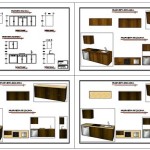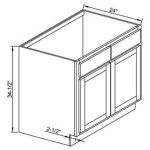Can You Spray Paint Kitchen Cabinets? A Comprehensive Guide
The question of whether kitchen cabinets can be spray painted is a frequent one among homeowners seeking to refresh their kitchen’s appearance without the expense of a full renovation. The answer, in short, is yes, kitchen cabinets can be spray painted. However, successful spray painting requires meticulous preparation, appropriate materials, and a thorough understanding of the process. This article will delve into the various aspects of spray painting kitchen cabinets, providing a detailed guide to help achieve a professional, durable finish.
Understanding the Benefits of Spray Painting Cabinets
Spray painting offers several advantages over traditional brush or roller application when refinishing kitchen cabinets. The primary benefit is the smooth, even finish that spray painting can achieve. Unlike brushes and rollers, which can leave visible brushstrokes or textures, spray painting atomizes the paint into a fine mist, resulting in a uniform coating across the cabinet surface. This is particularly important for modern kitchens where a flawless, factory-like appearance is often desired.
Another advantage is efficiency. Spray painting can cover large areas quickly, making it a time-saving option, especially for kitchens with numerous cabinets. The speed of application also minimizes the likelihood of dust particles settling on the wet paint, further contributing to a smoother finish. Additionally, spray painting allows for access to intricate details and recessed areas that can be challenging to reach with a brush or roller.
Furthermore, spray painting can accommodate a wider range of paint types, including those specifically formulated for cabinets. These specialized paints often provide enhanced durability, resistance to chipping and scratching, and improved adhesion to various cabinet materials. The proper application of a high-quality paint using a sprayer can significantly extend the lifespan of the refinished cabinets.
Detailed Preparation: The Foundation of a Successful Project
The key to achieving a professional spray-painted cabinet finish lies in meticulous preparation. This phase is often more time-consuming than the actual painting process, but it is crucial for ensuring proper adhesion, a smooth surface, and a long-lasting result. The preparation process involves several key steps, each of which plays a vital role in the overall success of the project.
First, the cabinets must be thoroughly cleaned. Grease, grime, and accumulated dirt are common on kitchen cabinets and will prevent the paint from adhering properly. A degreasing cleaner, such as trisodium phosphate (TSP) or a TSP substitute, should be used to remove all traces of contaminants. Rinse the cabinets thoroughly with clean water and allow them to dry completely before proceeding.
Next, the cabinets should be carefully inspected for any existing damage, such as chips, cracks, or peeling paint. These imperfections must be addressed before painting to prevent them from becoming more noticeable after the refinishing process. Fill any holes or gouges with wood filler, allow it to dry completely, and then sand it smooth to blend seamlessly with the surrounding surface.
Sanding is a critical step in the preparation process. It creates a slightly rough surface that allows the primer to grip the cabinets effectively. Use sandpaper with a grit of around 220 to lightly sand all surfaces that will be painted. For cabinets with a glossy finish, a coarser grit may be necessary to break through the sheen. After sanding, thoroughly remove all sanding dust with a vacuum cleaner and a tack cloth.
Priming is an essential step that should not be skipped. Primer provides a uniform surface for the paint to adhere to, seals any existing stains or imperfections, and enhances the overall durability of the finish. Choose a primer that is specifically designed for use on cabinets and that is compatible with the type of paint you will be using. Apply the primer in thin, even coats, following the manufacturer's instructions and allowing it to dry completely between coats.
Masking and protecting the surrounding areas is crucial to prevent overspray from damaging other surfaces. Use painter's tape and plastic sheeting to cover countertops, appliances, walls, floors, and any other areas that you do not want to be painted. Proper masking will save significant time and effort in cleaning up after the painting is completed.
Choosing the Right Equipment and Materials
The success of spray painting kitchen cabinets also depends on selecting the appropriate equipment and materials. The choice of sprayer, paint, primer, and other supplies can significantly impact the quality, durability, and appearance of the finished product. It is important to carefully consider the options available and choose those that are best suited for the specific project.
There are two main types of sprayers commonly used for painting cabinets: airless sprayers and HVLP (high volume, low pressure) sprayers. Airless sprayers are powerful and can cover large areas quickly, but they can also produce more overspray and require more skill to operate. HVLP sprayers, on the other hand, produce less overspray and offer greater control, making them a good choice for beginners. However, HVLP sprayers are generally slower than airless sprayers.
The choice of paint is also crucial. Cabinet-specific paints are formulated to provide a durable, scratch-resistant finish that can withstand the rigors of daily use. Alkyd paints and acrylic paints are both popular choices for cabinets. Alkyd paints offer a hard, durable finish, but they can be more difficult to clean up and may require the use of mineral spirits. Acrylic paints are water-based, making them easier to clean up, and they also offer good durability and color retention.
Primer is an essential component of the painting system. Choose a primer that is specifically designed for cabinets and that is compatible with the type of paint you will be using. A good primer will seal the cabinet surface, provide a uniform surface for the paint to adhere to, and enhance the overall durability of the finish. Tinted primers can also be used to improve the coverage of the topcoat, especially when painting cabinets a lighter color.
In addition to the sprayer, paint, and primer, several other supplies are necessary for a successful spray painting project. These include painter's tape, plastic sheeting, sandpaper, tack cloths, degreasing cleaner, wood filler, and safety equipment, such as a respirator and eye protection. Investing in high-quality supplies will help to ensure a professional, long-lasting finish.
When selecting materials, it is important to consider the existing cabinet material. Laminate cabinets will require a different type of primer and paint than solid wood cabinets. Ensure the chosen products are compatible with the cabinet substrate for optimal adhesion and durability. Consulting with paint professionals or reading product specifications can help in making the right selection.
Spray Painting Techniques for a Professional Finish
Even with proper preparation and high-quality materials, the application technique plays a significant role in the final result. Using the correct spray painting techniques will ensure an even, smooth, and durable finish on the kitchen cabinets. Mastering these techniques requires practice and patience, but it is essential for achieving a professional-looking outcome.
Before beginning, it is crucial to properly set up and test the sprayer. Adjust the spray pattern and pressure according to the manufacturer's instructions and the type of paint being used. Practice spraying on a piece of cardboard or scrap wood to get a feel for the sprayer and to fine-tune the settings. This will help to avoid common problems such as runs, drips, and uneven coverage.
When spraying, hold the sprayer at a consistent distance from the cabinet surface, typically around 6 to 8 inches. Maintain a steady, even motion, overlapping each pass by about 50%. Avoid arcing the sprayer, as this can result in uneven coverage. Instead, keep the sprayer parallel to the surface and move your entire arm rather than just your wrist.
Apply the paint in thin, even coats. Multiple thin coats are always preferable to one thick coat, as thick coats are more likely to run, drip, and take longer to dry. Allow each coat to dry completely before applying the next coat, following the manufacturer's instructions for drying time. Lightly sand between coats with fine-grit sandpaper (around 320 grit) to remove any imperfections and create a smooth surface for the next coat.
For cabinet doors and drawers, spray both the front and back surfaces, as well as the edges. Start by spraying the edges, then move on to the larger surfaces. Be sure to allow each surface to dry completely before flipping the piece over to spray the other side. Hanging the doors and drawers while they dry can help to prevent them from sticking to surfaces and can also improve airflow.
Pay close attention to corners and crevices, as these areas can be difficult to reach with the sprayer. Use a smaller spray tip or adjust the spray pattern to provide better coverage in these areas. Avoid spraying too much paint into corners, as this can lead to drips and runs. It might beneficial to use a small brush for detailed areas that are inaccessible to the spray gun.
After spraying, carefully inspect the cabinets for any imperfections, such as runs, drips, or missed spots. Touch up any areas as needed, using a small brush or the sprayer. Allow the paint to dry completely before reassembling the cabinets. It is recommended to allow the painted cabinets to cure for several days before putting them back into use, as this will allow the paint to fully harden and become more durable.
Clean the sprayer immediately after use to prevent the paint from drying and clogging the nozzle. Follow the manufacturer's instructions for cleaning the sprayer, using the appropriate cleaning solvents. Proper maintenance of the sprayer will ensure that it remains in good working condition and will provide consistent results for future painting projects.
Achieving a professional-quality spray paint finish on kitchen cabinets requires careful planning, preparation, and execution. By following these guidelines and taking the time to do the job right, homeowners can transform their kitchens without the expense of a full renovation. The final result will be a fresh, updated look that will enhance the value and enjoyment of the home.

3 Ways To Spray Kitchen Cabinets In The Sprayworks

Can You Spray Paint Cabinets First Home Love Life

How To Paint Kitchen Cabinets Like The Pros

Kitchen Spray Painting The Facelift Company

What Is The Best Spray Paint On Kitchen Cabinets

How To Spray Paint Cabinets Like The Pros Bright Green Door

Are Painted Kitchen Cabinets Durable Spray Painting

Best Way To Paint Cabinets Spray Or Brush

Want To Find Out How Spray Paint Kitchen Cabinets Like A Pro

How To Spray Paint Kitchen Units Pintyplus








